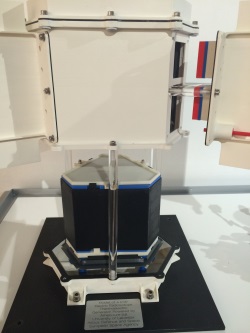Cosmic recycling
21 July 2014
Man has been sifting through trash for millennia, but the extraction of americium-241 waste from the UK's stockpile of civilian plutonium takes the exercise to a whole new dimension. Am-241 - a decay product of plutonium-241 - is the most prevalent isotope of americium in long-term stored plutonium and is currently considered to be waste.
The National Nuclear Laboratory (NNL) in north-west England is just two years away from producing the first developmental pellets of Am-241 for radioisotope power sources (RPS) in its contract with the European Space Agency (ESA). Sourcing plutonium for the project from the nearby Sellafield nuclear complex, NNL chemists hope the Am-241 they are producing could one day be used in thermoelectric generators to power deep space programs.
 |
| A full-size model of a 10We americium-powered battery. The black triangular aeroshell contains the heat source while its cover and extending cooling fins are raised above (Image: NNL) |
"Am-241 could enable missions to the outer solar system, where there could be life, potentially," Tim Tinsley, NNL business leader for spent fuel management technology, told World Nuclear News on 16 July. "I'd love to see a space probe go up with the NNL logo on the side," he said.
Tinsley spoke at the Farnborough Air Show in Hampshire – a week-long UK trade exhibition for the aerospace and defence industries – in which NNL for the first time took part. The agency has so far provided NNL with £3 million ($4.01 million) in funding for its Am-241 project, the second and latest contract for which ends in mid-2016.
RPS batteries are long-life devices used, not to launch spacecraft, but to keep instruments running over several decades. They have been used in space since the 1960s – NASA used them in their latest Curiosity craft on Mars – but they currently rely on a costly and scarce resource, plutonium-238 (Pu-238).
Advantages
Pu-238 may be the "well-established" and "technically superior choice" of space power radioisotope, ESA nuclear power system engineer Keith Stephenson said, but it is very expensive to produce because it requires reactor irradiation and multiple separation steps. Am-241 has only one-quarter the power of Pu-238, but it is more affordable, he said.
"Building a 10 kilogram per year Am-241 production facility, running it for ten years and then decommissioning it could be done with tens of millions of dollars compared with hundreds of millions of dollars for a similar Pu-238 plant," Stephenson said.
Nuclear power is required "if you want to go beyond Jupiter, or if you want to land on a planet and do a mission of significant length"
Keith Stephenson, ESA
Around 250 kg of civilian plutonium is needed to harvest 10 kg of Am-241. Military-grade plutonium cannot be used to produce Am-241 as it does not contain significant amounts of Pu-241.
Using Am-241 instead of Pu-238 could therefore enable more countries to join the USA and Russia in having their own space missions, Stephenson said. At the same time, Am-241 radioisotope power systems could become a multi-million dollar export product for the UK to states that have so far been reliant for their space programs on Pu-238 or solar power, he said.
Juno, the mission to Jupiter that NASA launched in 2011, proved that the use of solar power "is possible beyond Mars," Tinsley said, but it doesn't last very long and requires huge panels. Similarly, the Rosetta mission ESA launched in 2004 "went as far as Jupiter, but had to be put to sleep and then reawakened a couple of months ago," he said.
Nuclear power is required "if you want to go beyond Jupiter, or if you want to land on a planet and do a mission of significant length," Stephenson said. "With Jupiter you can conceive of surviving with solar power, but with Saturn, Uranus and Neptune, it's inconceivable," he said.
Next steps
NNL has produced and analysed more than 350 milligrams of Am-241 and by mid-2016 it will have produced at least 4 grams, which is "a very large quantity for americium," Tinsley said. It has also achieved a "phenomenally good" level of purity of 99.7% or greater, he said. An Am-241 RPS "space battery" – could be flying, literally, in less than a decade, he said.
Am-241 comes from the radioactive decay of Pu-241. It can be isolated by chemical separations as follows: by dissolving plutonium dioxide in a silver-catalysed process, separating the plutonium from americium/silver, separating americium from silver and then recovering the silver.
"We don't believe there is any technological barrier to these systems – we can get the fuel, put it in a safe configuration and generate electricity from it," he said. "It all now comes down to money and political will."
It was encouraging therefore, he said, to see British government ministers and the UK Space Agency announce at the same air show on 15 July the shortlist of locations for Britain's first "spaceport", which is planned for 2018.
But it isn't yet clear whether ESA member states will regard NNL's Am-241 project as a short or long-term option, Stephenson said.
"They may decide to look just at radioisotope heater units, which would mean the next stage for NNL would be to develop a capability between a laboratory and full-scale production. But if they say they are interested in the long term and in seeing if we can make electrical systems, like radioisotope thermoelectric generators, then we'd be looking at requiring multiple kilograms of Am-241, and moving from chemistry and into engineering development," he said.
Tinsley added: "If we can advance the system, then that might make choices easier for ESA because we'll be able to make it a here-and-now [option]. If we can develop these systems ourselves, then potentially the UK could export fully configured radioisotope power system units to ESA or to other countries."
Researched and written
by World Nuclear News